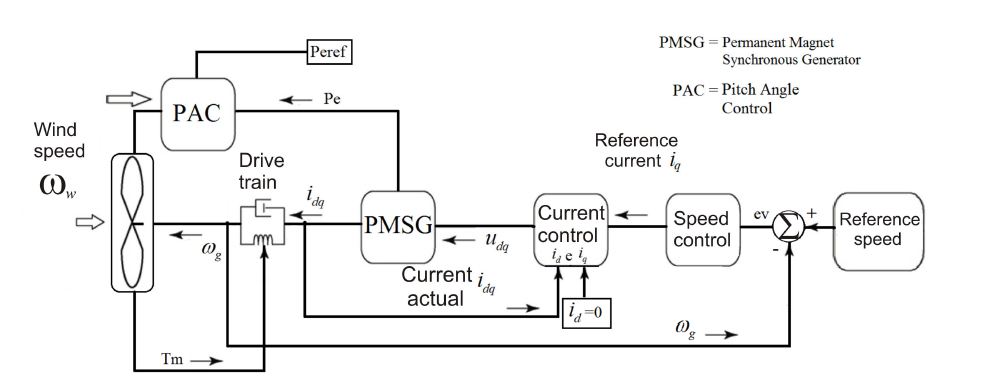Modelling of a Wind Turbine with Permanent Magnet Synchronous Generator
Objective
The main objective of this project is the implementation and simulation of a Simulink-based controlled permanent magnet synchronous generator (PMSG) wind turbine in the dq0 reference frame.
Abstract
In this project, presents the
implementation and simulation of a Simulink-based controlled Permanent Magnet Synchronous
Generator (PMSG) wind turbine in the dq0 reference frame. The model consists of
a current control subsystem, a PMSG model, a mechanical subsystem, a pitch angle
controller and a wind turbine model.
The current control subsystem makes use of PI controllers governing the wind turbine speed, the direct and quadrature stator currents and the pitch angle of the turbine blades. The pitch angle controller measures the speed and the active power from the generator limiting both in case of high-speed wind conditions.
In order to verify the functioning and the effectiveness of the proposed controllers, simulations- for different operation conditions- are presented and discussed. The performance of the proposed controller results evaluated by using Matlab/Simulink software.
Keywords: Permanent magnet synchronous generator, Wind Turbine, Control, Modeling.
NOTE: Without the concern of our team, please don't submit to the college. This Abstract varies based on student requirements.
Block Diagram

Specifications
Software Configuration:
Operating System : Windows 7/8/10
Application Software : Matlab/Simulink
Hardware Configuration:
RAM : 8 GB
Processor : I3 / I5(Mostly prefer)
Learning Outcomes
- Introduction to Matlab/Simulink
- What is EISPACK & LINPACK
- How to start with MATLAB
- About Matlab language
- About tools & libraries
- Application of Matlab/Simulink
- About Matlab desktop
- Features of Matlab/Simulink
- Basics on Matlab/Simulink
- Introduction to motors.
- Design of interior Permanent magnet synchronous motor.
- Introduction to electrical drives.
- Analysis of power converters.
- Introduction to controllers.
- We can learn about synchronous reference frame theory.
- We can learn about Clark’s transformation.
- Design of pi controller.
- Introduction to the types of filters.
- Introduction to closed loop, open loop control methods.
- Study of PWM techniques.
- Design of SVPWM technique.
- Design of torque limiter.
- Study of various electrical braking methods.
- Project Development Skills:
- Problem analyzing skills
- Problem solving skills
- Creativity and imaginary skills
- Programming skills
- Deployment
- Testing skills
- Debugging skills
- Project presentation skills
- Thesis writing skills


 Paper Publishing
Paper Publishing
